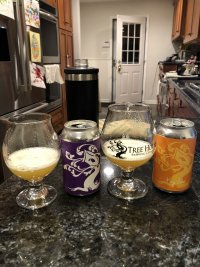beervoid
Hophead & Pellet Rubber
I think this is key, the double ipa's have those esters going on. Og is directly related to ester formation.Agreed, or they might be even using a entirely different yeast all together and not the ones were using. I haven't brewed in a while but Ill give it a shot soon and play around more with different yeast. I wonder if they are even naturally carbonating anymore with the amount of beer they are pumping out. I'm sure there were process changes along the way. So many people bashing treehouse these days its crazy. I've noticed a dip in quality as well. To me, only the double IPA's have that strong yeast ester going on.
Apart from maybe not using the right yeast perhaps we should focus more on pushing any particular yeast to maximize esters.
Start with a high og. Low aeration. The right nutrition.
I've gotten some valine and l-leucine to play with on batches.


































![Craft A Brew - Safale BE-256 Yeast - Fermentis - Belgian Ale Dry Yeast - For Belgian & Strong Ales - Ingredients for Home Brewing - Beer Making Supplies - [3 Pack]](https://m.media-amazon.com/images/I/51bcKEwQmWL._SL500_.jpg)























